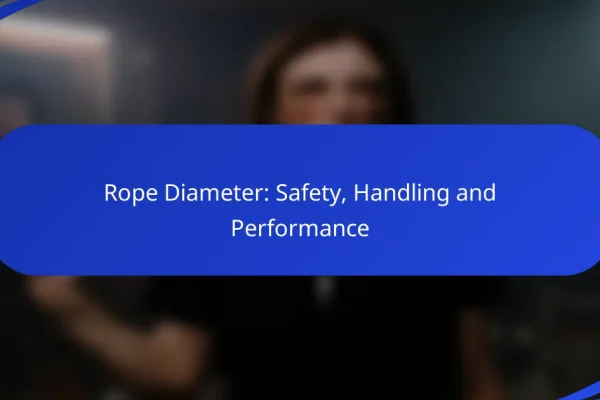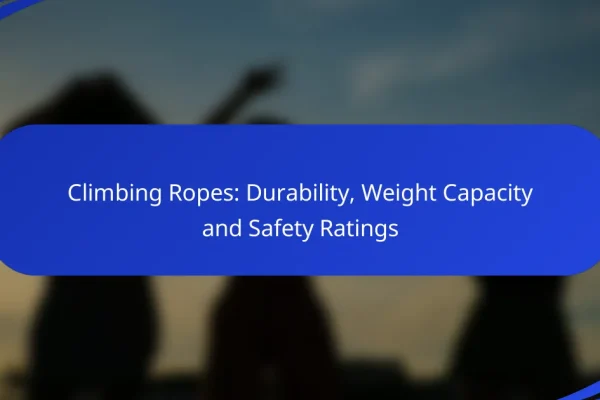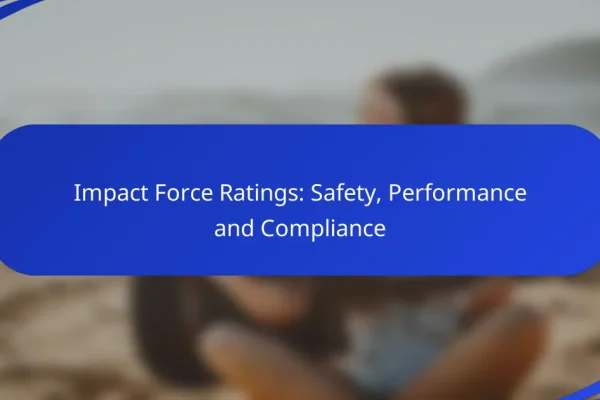What are the best climbing ropes for outdoor use?
The best climbing ropes for outdoor use are lightweight, durable, and suitable for various climbing styles. When selecting a rope, consider factors such as diameter, length, and intended use to ensure optimal performance and safety.
Petzl Volta 9.2 mm
The Petzl Volta 9.2 mm is a popular choice among climbers for its balance of weight and durability. Weighing around 58 grams per meter, it is designed for sport climbing and multi-pitch routes, making it versatile for outdoor adventures.
This rope features a dry treatment that enhances its resistance to moisture and dirt, which is crucial for outdoor conditions. It meets the UIAA standards for dynamic ropes, ensuring safety during falls.
Mammut Infinity 9.5 mm
The Mammut Infinity 9.5 mm rope is known for its excellent handling and durability, making it suitable for both sport and trad climbing. With a weight of approximately 63 grams per meter, it strikes a good balance between performance and ease of use.
This rope is also treated with a water-repellent finish, which helps maintain its integrity in wet conditions. It complies with the EN 892 standard, ensuring it meets safety requirements for climbing ropes.
Black Diamond 9.4 mm
The Black Diamond 9.4 mm rope is favored for its lightweight design and versatility, weighing about 59 grams per meter. It is ideal for climbers looking for a rope that performs well in various outdoor settings, from sport routes to alpine climbs.
Featuring a durable sheath and a dry treatment, this rope is designed to withstand the rigors of outdoor use. It adheres to UIAA standards, providing peace of mind regarding safety during climbs.
How do I choose a climbing rope?
Choosing a climbing rope involves understanding your climbing style, the type of climbing you will do, and the specific features of the rope. Key factors include rope type, diameter, length, and certification standards to ensure safety and performance.
Consider rope type
There are two main types of climbing ropes: dynamic and static. Dynamic ropes are designed to stretch under load, making them ideal for lead climbing and falls. Static ropes, on the other hand, have minimal stretch and are better suited for activities like rappelling or rescue operations.
When selecting a rope type, consider your climbing activities. For sport climbing, a dynamic rope is essential, while a static rope is preferable for caving or hauling gear. Always match the rope type to your intended use for optimal safety and performance.
Evaluate diameter and length
The diameter and length of a climbing rope significantly affect its weight, durability, and handling. Ropes typically range from about 8.5 mm to 11 mm in diameter, with thinner ropes being lighter but potentially less durable. For most sport climbing, a rope between 9.5 mm and 10.5 mm is a good balance of weight and strength.
Length is also crucial; common lengths are 60 m and 70 m. Choose a length that suits your climbing routes, keeping in mind that longer ropes can be heavier and more cumbersome. Always consider the maximum fall distance and the height of your climbs when selecting the appropriate length.
Check for UIAA certification
UIAA certification indicates that a climbing rope meets specific safety standards. Look for ropes that have been tested and certified by the International Climbing and Mountaineering Federation (UIAA) to ensure they can withstand the forces of a fall.
Ropes that are UIAA certified will typically have a label or tag indicating compliance. This certification is crucial for safety, as it ensures the rope has undergone rigorous testing for strength, durability, and performance. Avoid using ropes without this certification, as they may not provide the necessary safety features for climbing.
What are the differences between dynamic and static climbing ropes?
Dynamic climbing ropes are designed to stretch under load, making them ideal for protecting climbers during falls. In contrast, static climbing ropes do not stretch, making them suitable for applications like rappelling or rescue operations.
Dynamic ropes stretch under load
Dynamic ropes are constructed to absorb the energy generated during a fall by elongating. This stretch helps reduce the impact force on the climber and the gear, which can be crucial for safety. Typically, dynamic ropes can stretch up to 30% of their original length when loaded.
When selecting a dynamic rope, consider its fall rating and UIAA certification, which indicate its ability to withstand falls. A rope with a lower impact force rating is generally more forgiving during a fall, making it a better choice for sport climbing or lead climbing.
Static ropes do not stretch
Static ropes are designed for minimal stretch, which provides stability and control during activities where movement is limited. These ropes are commonly used in situations like caving, rescue operations, or when hauling gear. The lack of stretch allows for precise handling and positioning.
When using static ropes, ensure they are rated for the specific application, as they are not suitable for climbing where falls may occur. Always check for wear and tear, as static ropes can be more susceptible to abrasion due to their lack of elasticity.
What is the average lifespan of a climbing rope?
The average lifespan of a climbing rope typically ranges from 3 to 10 years, depending on usage and storage conditions. Regular use can significantly shorten a rope’s life, while proper care can extend it considerably.
3 to 5 years with regular use
Climbing ropes that are used frequently, such as in regular outdoor climbing or gym sessions, usually last between 3 to 5 years. Factors like the intensity of use, exposure to elements, and the type of climbing can all impact this lifespan.
To maximize durability, inspect your rope regularly for signs of wear, such as fraying or discoloration. If you notice significant damage, it’s best to retire the rope sooner rather than later to ensure safety.
Up to 10 years if stored properly
If a climbing rope is stored correctly and not used excessively, it can last up to 10 years. Proper storage includes keeping the rope in a cool, dry place away from direct sunlight and moisture, which can degrade the material over time.
Additionally, avoid exposing the rope to harsh chemicals or sharp objects. Regularly cleaning the rope according to the manufacturer’s guidelines can also help maintain its integrity and extend its lifespan.
What are the safety ratings for climbing ropes?
Climbing ropes are rated for safety based on their ability to withstand forces during falls. The most recognized ratings come from organizations like UIAA and CE, which ensure that ropes meet specific performance standards for durability and reliability.
UIAA certification standards
The UIAA (International Climbing and Mountaineering Federation) sets rigorous testing protocols for climbing ropes. Ropes that meet these standards undergo tests for dynamic elongation, impact force, and number of falls endured. A UIAA-certified rope is a reliable choice for climbers, as it guarantees that the rope has passed essential safety tests.
For example, a dynamic rope must withstand a minimum impact force of around 8-10 kN and endure at least five falls during testing. This certification helps climbers assess the rope’s performance under real-world conditions.
CE marking requirements
The CE marking indicates that a climbing rope meets European safety standards. To obtain this mark, ropes must comply with the EN 892 standard, which covers requirements for dynamic ropes used in climbing. This includes testing for strength, durability, and performance in various conditions.
Climbers should look for the CE mark on ropes, as it signifies that the product has been evaluated for safety and quality. It’s also advisable to check for additional markings that indicate compliance with UIAA standards, as this can provide extra assurance of the rope’s reliability.
How do I maintain my climbing rope?
Maintaining your climbing rope is essential for safety and longevity. Regular cleaning and proper storage can significantly extend the life of your rope and ensure it performs well during climbs.
Regular cleaning methods
To maintain your climbing rope, clean it regularly, especially after exposure to dirt, saltwater, or other contaminants. Use a mild soap and lukewarm water, and wash the rope in a bathtub or similar container, ensuring it is fully submerged.
For deeper cleaning, consider using a rope-specific cleaner. Avoid using harsh chemicals or washing machines, as these can damage the fibers. After washing, rinse thoroughly and hang the rope to dry away from direct sunlight to prevent UV damage.
Proper storage techniques
Store your climbing rope in a cool, dry place, away from direct sunlight and extreme temperatures. A rope bag or a dedicated storage container can protect it from dirt and abrasion.
When not in use, avoid coiling the rope too tightly, as this can create kinks and damage the fibers. Instead, use a loose figure-eight or a similar method to keep it organized while minimizing stress on the rope.
What are the best climbing rope brands?
The best climbing rope brands are known for their durability, safety, and performance. Key players in the industry include Petzl, Mammut, and Black Diamond, each offering unique features and specifications tailored to different climbing needs.
Petzl
Petzl is renowned for its high-quality climbing gear, particularly its ropes designed for sport climbing and mountaineering. Their ropes often feature advanced technologies like the Dry treatment, which enhances water resistance and durability.
When choosing a Petzl rope, consider the type of climbing you will be doing. For instance, their Volta series is lightweight and ideal for sport climbing, while the Arial series offers more durability for multi-pitch routes.
Mammut
Mammut is another top brand recognized for its innovative climbing ropes, which combine safety with performance. Their ropes are often made with high-quality materials that provide excellent abrasion resistance and low stretch.
Look for Mammut’s Infinity series for versatile all-around use, or the Smart Protect series if you need a rope that excels in wet conditions. These options cater to various climbing styles, from sport to alpine climbing.
Black Diamond
Black Diamond is a trusted name in climbing equipment, offering a range of ropes that are both reliable and performance-driven. Their ropes are designed with features like a durable sheath and a dynamic core for optimal shock absorption.
For sport climbers, the Black Diamond 9.9 rope is a popular choice due to its balance of weight and durability. If you are into trad climbing, consider their 10.2 rope, which provides extra safety margins for protection placements.












